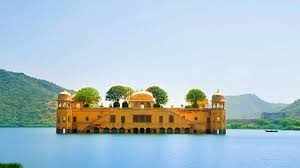Rajasthan News Desk !!! Whenever tigers are talked about in the world, the first name that comes to everyone’s mind is Ranthambore Tiger Reserve, this is the tiger reserve that has completely changed the definition of tiger and wildlife sighting. Ranthambore is the name due to which not one or two but four tiger reserves of India are alive today.
The name Ranthambore has its own definition, which is made up of three different words, the first word is Ran which means battlefield, the second word is Thumb which shows the 7 kilometer long single hill here as a pillar, and the third word is Bhor, which shows the space between the battlefield and the hill as a vortex. These words show the place which is home to more than 80 tigers today. Situated in the foothills of Vindhya and Aravali hills, Ranthambore is known not only for tigers but also for the diversity of flora and fauna. Spread over an area of 392 square kilometers, Ranthambore National Park is located on the edge of the Hadoti plateau, which is spread over a vast plain area north of the Chambal River and south of the Banas River. Ranthambore Sanctuary is named after the famous Ranthambore Fort here, so let’s go for a tiger safari in Ranthambore National Park today.
Ranthambore National Park is located in Sawai Madhopur district of Rajasthan, it is counted among the big national parks of North India. Ranthambore Park was established by the Government of India in 1955 as Sawai Madhopur Game Sanctuary. Later, concerned about the decreasing number of tigers across the country, the government declared it as Project Tiger Sanctuary in 1973 and started the exercise of tiger conservation. The sanctuary and the state benefited from this project and Ranthambore became a major center of safari tourism. Due to this, Ranthambore was declared a national sanctuary in 1984. Since 1984, the sanctuaries and forest areas of the state were continuously protected. In the year 1984, ‘Sawai Mansingh Sanctuary’ and ‘Keoladeo Sanctuary’ were also declared, and later both these new sanctuaries were also added to the tiger conservation project.
Ranthambhore National Park is home to many indigenous and exotic species of animals, birds, amphibians, reptiles, flora and fauna, along with one of the most amazing tiger species in the world. According to records, a total of 35 species of reptiles, 40 species of mammals and 320 species of birds are found in this park. This tiger reserve is called the sanctuary of tigers, but there is also a large number of other wildlife present here, including leopards, caracals, fishing cats, wild cats, jackals, leopards, hyenas, swamp crocodiles, wild boars and various species of deer. Many migratory birds come here in winter, including eagles, crested serpent eagle, great Indian horned owl, pheasants, painted pheasants, quails, spurfowl peacock, tree pie and many types of storks. This natural diversity makes this park the best place for wildlife lovers and bird watchers. This sanctuary is home to a variety of vegetation, trees, plants, vines, small creatures and birds. India’s largest banyan tree is also a popular site in Ranthambore. The flora species of Ranthambore National Park mainly include Dhok, Banyan, Peepal, Neem, Mango, Tamarind, Jamun, Ber, Chila, Babul, Gum, Gurjan, Kadam, Khair, Date Palm, Kakera, Karel, Khimi, Kikar, Mahua and Salar.
There are a total of 10 safari zones in Ranthambore National Park, each of which has its own beauty and specialty. Different types of wild animals or birds can be seen in each zone. But when it comes to tigers, there are only a few special zones where the chances of seeing these tigers increase. There are 5 zones in the core area of Ranthambore National Park. It is believed that tigers are most likely to be seen in these 5 zones. Zones 1 to 3 of the forest have the densest forests, water ponds and rocky areas, which make them ideal places for tigers to live and hide. Tourists and jungle safari guides believe that tigers are most visible in Gate No. 3, also known as Sultanpur Gate. Zones 6 to 10 are present in the buffer area of Ranthambore National Park.
Today, there are about 84 tigers and tigresses in the 1700 square kilometer Ranthambore National Park, which includes 25 tigers, 25 tigresses and 34 cubs. Ranthambore has been home to many famous tigers, including the world’s most famous tigress Machli, King Salman of Ranthambore, Nora known for her maternal instinct and hunting skills, Tiger T 73 known for its huge size and powerful roar, Romeo, Laila, Dollar, Ustad, Mala, Junglee, Bina One, Bina Two and Sitara.
The most famous tigress of Ranthambore National Park is known as Machli. Machli is the tigress who has been photographed the most in the world, along with this Machli also holds the record of being the richest tigress in the world and the most popular tigress in the world. Machli was born in 1997. This tigress had a fish-shaped mark on the left side of her face, due to which she was named Machli. Machli started hunting at the age of 2 and occupied her mother’s territory. Some world records are also registered in her name, like a tiger can occupy an area for an average of 7-8 years, but Machli was the only tigress in the world who ruled the entire Ranthambore National Park for 15 years. Machli once killed a 13 feet long crocodile in a fight, after which she was also given various nicknames like The Lady of the Lake and Crocodile Killer across the world. Machhli has also received the Lifetime Achievement Award.
If you have come to visit Ranthambore Sanctuary, then you can also visit the Ranthambore Fort located inside this park. This fort has been the former hunting ground of the Maharajas of Jaipur. Apart from this, you can also visit Ganesh Trinetra Temple, one of the most famous temples of Lord Ganesha located near this park. Along with this, people who come here to visit, build small stone houses near the temple, so that their wish of building a real house can be fulfilled.
All the tourist zones of Ranthambore National Park are open for jungle safari from 1 October to 30 June. In the remaining months of the year i.e. July to September, zones 1 to 5 of the park remain closed for tourists due to monsoon season, while zones 6 to 10 remain open for safari in monsoon. Although the park remains open for safari during the monsoon season, but the time from November to April is considered the best time to visit Ranthambore National Park. Because at this time the chances of seeing tigers are the highest.
There are two types of jungle safaris available in Ranthambore National Park and Tiger Reserve, jeep safari and canter safari. For both types of safaris, you have to book your seat in advance which can be booked both online and offline. Tourists can book morning and evening jungle safaris. Generally, morning safari is from 06:30 am to 10:00 am and evening safari is from 02:30 pm to 06:00 pm. However, the safari timings may vary according to the season. For jeep safari, Indian citizens have to spend Rs. 1350 per person and foreign citizens have to spend Rs. 2500 per person. Whereas for canter safari, Indian citizens have to spend Rs. 815 per person and foreign citizens have to spend Rs. 2000 per person.
Ranthambore National Park is well connected to all parts of the country, if you want to travel to Ranthambore National Park by plane, then let us tell you that its nearest airport is Jaipur. Which is located just 180 km from the park. The nearest railway station to travel to Ranthambore National Park by rail is Sawai Madhopur Railway Station. Ranthambore National Park is located at a distance of about 12 km from here. The nearest bus station to reach Ranthambore National Park by road is Sawai Madhopur. Which is located just 11 km from the park. From the airport, railway station and bus stand, you can take the help of taxi or cab to reach the Tiger Reserve.


